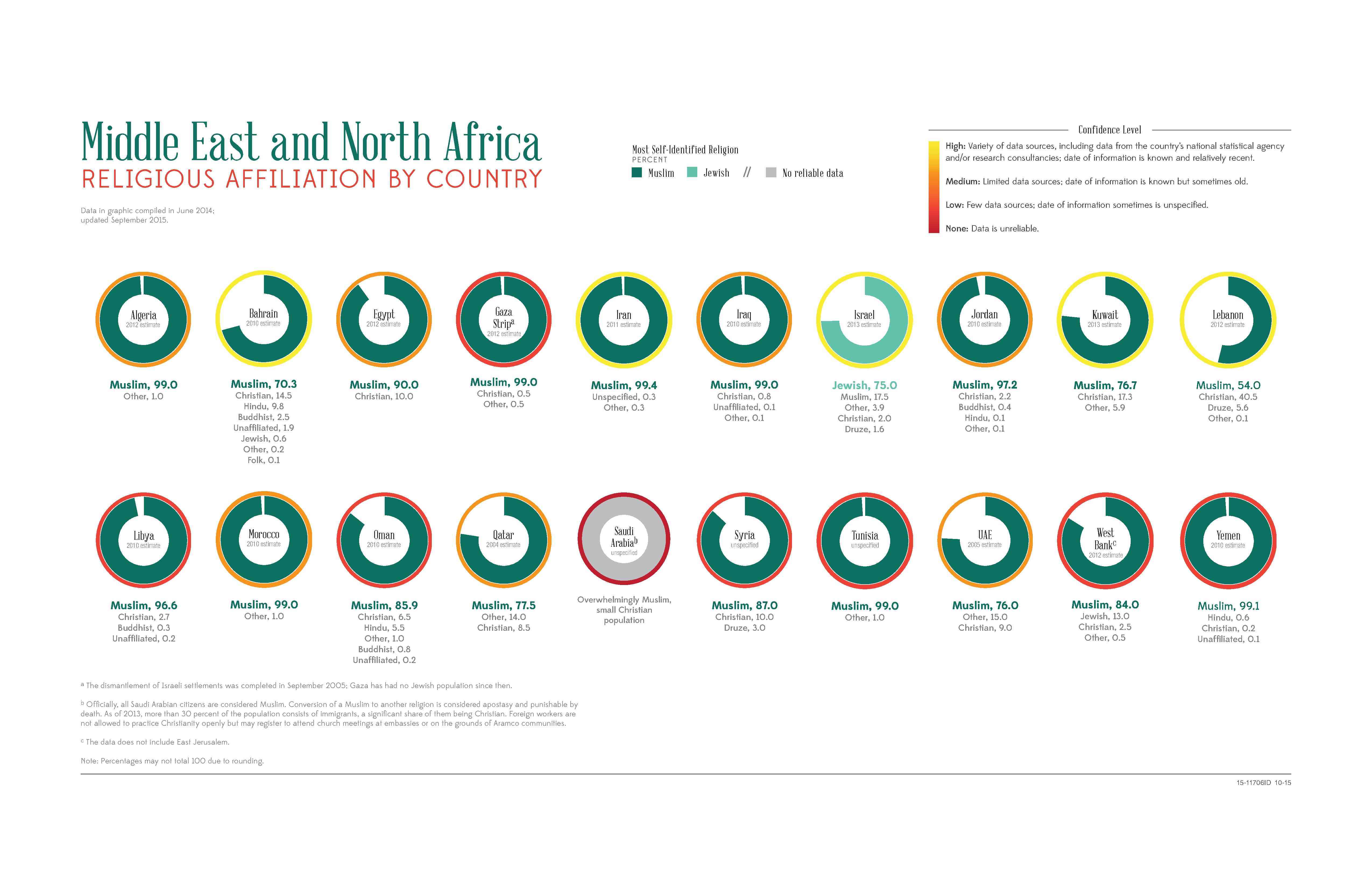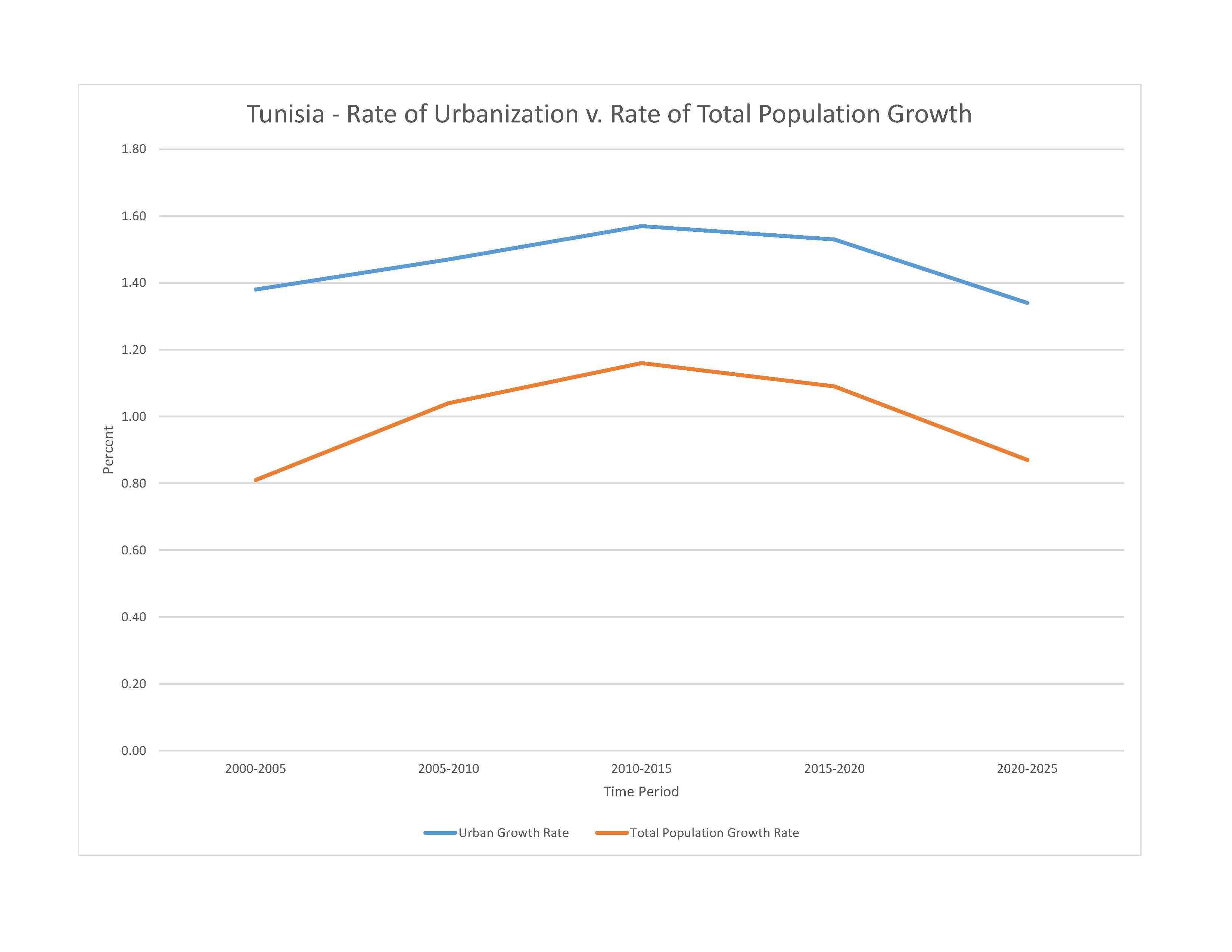
11,976,182 (2023 est.)
noun: Tunisian(s)
adjective: Tunisian
Arab 98%, European 1%, Jewish and other 1%
Arabic (official, one of the languages of commerce), French (commerce), Tamazight; note - despite having no official status, French plays a major role in the country and is spoken by about two thirds of the population
major-language sample(s):
كتاب حقائق العالم، أحسن كتاب تتعلم به المعلومات الأساسية (Arabic)
The World Factbook, une source indispensable d'informations de base. (French)
The World Factbook, the indispensable source for basic information.
Arabic audio sample:
French audio sample:
Muslim (official; Sunni) 99%, other (includes Christian, Jewish, Shia Muslim, and Baha'i) 
The Tunisian Government took steps in the 1960s to decrease population growth and gender inequality in order to improve socioeconomic development. Through its introduction of a national family planning program (the first in Africa) and by raising the legal age of marriage, Tunisia rapidly reduced its total fertility rate from about 7 children per woman in 1960 to 2 in 2022. Unlike many of its North African and Middle Eastern neighbors, Tunisia will soon be shifting from being a youth-bulge country to having a transitional age structure, characterized by lower fertility and mortality rates, a slower population growth rate, a rising median age, and a longer average life expectancy.
Currently, the sizable young working-age population is straining Tunisia’s labor market and education and health care systems. Persistent high unemployment among Tunisia’s growing workforce, particularly its increasing number of university graduates and women, was a key factor in the uprisings that led to the overthrow of the BEN ALI regime in 2011. In the near term, Tunisia’s large number of jobless young, working-age adults; deficiencies in primary and secondary education; and the ongoing lack of job creation and skills mismatches could contribute to future unrest. In the longer term, a sustained low fertility rate will shrink future youth cohorts and alleviate demographic pressure on Tunisia’s labor market, but employment and education hurdles will still need to be addressed.
Tunisia has a history of labor emigration. In the 1960s, workers migrated to European countries to escape poor economic conditions and to fill Europe’s need for low-skilled labor in construction and manufacturing. The Tunisian Government signed bilateral labor agreements with France, Germany, Belgium, Hungary, and the Netherlands, with the expectation that Tunisian workers would eventually return home. At the same time, growing numbers of Tunisians headed to Libya, often illegally, to work in the expanding oil industry. In the mid-1970s, with European countries beginning to restrict immigration and Tunisian-Libyan tensions brewing, Tunisian economic migrants turned toward the Gulf countries. After mass expulsions from Libya in 1983, Tunisian migrants increasingly sought family reunification in Europe or moved illegally to southern Europe, while Tunisia itself developed into a transit point for Sub-Saharan migrants heading to Europe.
Following the ousting of BEN ALI in 2011, the illegal migration of unemployed Tunisian youths to Italy and onward to France soared into the tens of thousands. Thousands more Tunisian and foreign workers escaping civil war in Libya flooded into Tunisia and joined the exodus. A readmission agreement signed by Italy and Tunisia in April 2011 helped stem the outflow, leaving Tunisia and international organizations to repatriate, resettle, or accommodate some 1 million Libyans and third-country nationals.
0-14 years: 24.77% (male 1,529,179/female 1,436,771)
15-64 years: 65.26% (male 3,843,642/female 3,971,509)
65 years and over: 9.98% (2023 est.) (male 566,265/female 628,816)
total dependency ratio: 50.9
youth dependency ratio: 36.3
elderly dependency ratio: 13.3
potential support ratio: 7.5 (2021 est.)
total: 34 years (2023 est.)
male: 33.2 years
female: 34.7 years
0.63% (2023 est.)
14.1 births/1,000 population (2023 est.)
6.4 deaths/1,000 population (2023 est.)
-1.3 migrant(s)/1,000 population (2023 est.)
the overwhelming majority of the population is located in the northern half of the country; the south remains largely underpopulated as shown in this 
urban population: 70.5% of total population (2023)
rate of urbanization: 1.34% annual rate of change (2020-25 est.)

2.475 million TUNIS (capital) (2023)
at birth: 1.06 male(s)/female
0-14 years: 1.06 male(s)/female
15-64 years: 0.97 male(s)/female
65 years and over: 0.9 male(s)/female
total population: 0.98 male(s)/female (2023 est.)
37 deaths/100,000 live births (2020 est.)
total: 11.6 deaths/1,000 live births (2023 est.)
male: 13 deaths/1,000 live births
female: 10.1 deaths/1,000 live births
total population: 77.1 years (2023 est.)
male: 75.4 years
female: 78.8 years
1.96 children born/woman (2023 est.)
0.95 (2023 est.)
50.7% (2018)
improved: urban: 100% of population
rural: 97.3% of population
total: 99.2% of population
unimproved: urban: 0% of population
rural: 2.7% of population
total: 0.8% of population (2020 est.)
6.3% of GDP (2020)
1.3 physicians/1,000 population (2017)
2.2 beds/1,000 population (2017)
improved: urban: 98.8% of population
rural: 99.4% of population
total: 99% of population
unimproved: urban: 1.2% of population
rural: 0.6% of population
total: 1% of population (2020 est.)
26.9% (2016)
total: 1.51 liters of pure alcohol (2019 est.)
beer: 0.99 liters of pure alcohol (2019 est.)
wine: 0.32 liters of pure alcohol (2019 est.)
spirits: 0.17 liters of pure alcohol (2019 est.)
other alcohols: 0.03 liters of pure alcohol (2019 est.)
total: 24.6% (2020 est.)
male: 47.2% (2020 est.)
female: 2% (2020 est.)
1.6% (2018)
53.9% (2023 est.)
women married by age 15: 1.5% (2018 est.)
7.3% of GDP (2016 est.)
definition: age 15 and over can read and write
total population: 82.7%
male: 89.1%
female: 82.7% (2021)
total: 15 years
male: 14 years
female: 16 years (2016)
NOTE: The information regarding Tunisia on this page is re-published from the 2024 World Fact Book of the United States Central Intelligence Agency and other sources. No claims are made regarding the accuracy of Tunisia 2024 information contained here. All suggestions for corrections of any errors about Tunisia 2024 should be addressed to the CIA or the source cited on each page.
This page was last modified 04 May 24, Copyright © 2024 ITA all rights reserved.